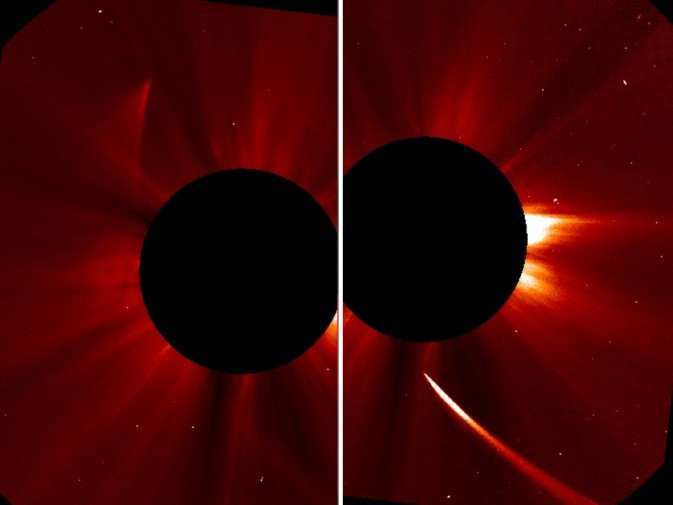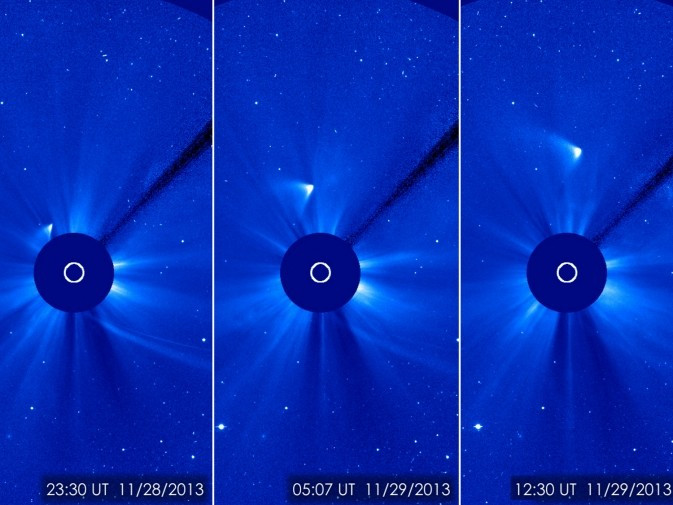Comet Ison is Dead: Astrophysicist Karl Battams Writes Obituary For Comet of the Century

Comet Ison appears to have died on its journey around the Sun, having broken up into small pieces over the last few days.
Dubbed the Comet of the Century, Ison was an extremely rare sungrazer, in that it came very close to the Sun's surface - about 1.2 million miles at its closest point.
It was unclear whether Ison would make it round the Sun in one piece after 28<sup>th November and scientists have been waiting to find out its fate.
Initially, it was thought Ison had not survived its close encounter, however it appeared to come back to life, with Nasa saying it "may have survived".
"As Ison appeared to dim and fizzle in several observatories and later could not be seen at all by Nasa's Solar Dynamics Observatory or by ground based solar observatories, many scientists believed it had disintegrated completely.
"However, a streak of bright material streaming away from the sun appeared in the European Space Agency and Nasa's Solar and Heliospheric Observatory later in the evening. The question remains whether it is merely debris from the comet, or if some portion of the comet's nucleus survived, but late-night analysis from scientists with NASA's Comet ISON Observing Campaign suggest that there is at least a small nucleus intact."

Despite this hope, it is now thought Ison has died, and in tribute Karl Battams, an astrophysicist at the US Naval Research Laboratory in Washington DC, wrote an obituary for the ill-fated comet.
"Born in a dusty and turbulent environment, comet Ison spent its early years being jostled and struck by siblings both large and small, he wrote for the Nasa Comet Ison Observing Campaign.
"Surviving a particularly violent first few million years, Ison retreated to the Oort Cloud, where it maintained a largely reclusive existence for nearly four billion years. But around three-million BC, a chance encounter with a passing star coerced Ison into undertaking a pioneering career as a sungrazer.
"On September 21, 2012, Ison made itself known to us, and allowed us to catalogue the most extraordinary part of its spectacular vocational calling.

"Never one to follow convention, Ison lived a dynamic and unpredictable life, alternating between periods of quiet reflection and violent outburst. However, its toughened exterior belied a complex and delicate inner working that only now we are just beginning to understand.
"In late 2013, Comet Ison demonstrated not only its true beauty but a surprising turn of speed as it reached its career defining moment in the inner solar system. Tragically, on November 28, 2013, Ison's tenacious ambition outweighed its ability, and our shining green candle in the solar wind began to burn out.
"Survived by approximately several trillion siblings, Comet Ison leaves behind an unprecedented legacy for astronomers, and the eternal gratitude of an enthralled global audience.
"In ISON's memory, donations are encouraged to your local astronomy club, observatory or charity that supports STEM and science outreach programs for children."
Read more:
Comet Ison: Will Flip of Sun's Magnetic Field Affect Comet of the Century? [VIDEO]
Comet Ison Particles to Provide Cosmic Time Capsule as Moment of Truth Approaches
Comet of the Century: Ison Could Hold Clues to Life on Earth
Death of Ison: Comet of the Century to Fizzle and 'Break Up'
© Copyright IBTimes 2025. All rights reserved.





















